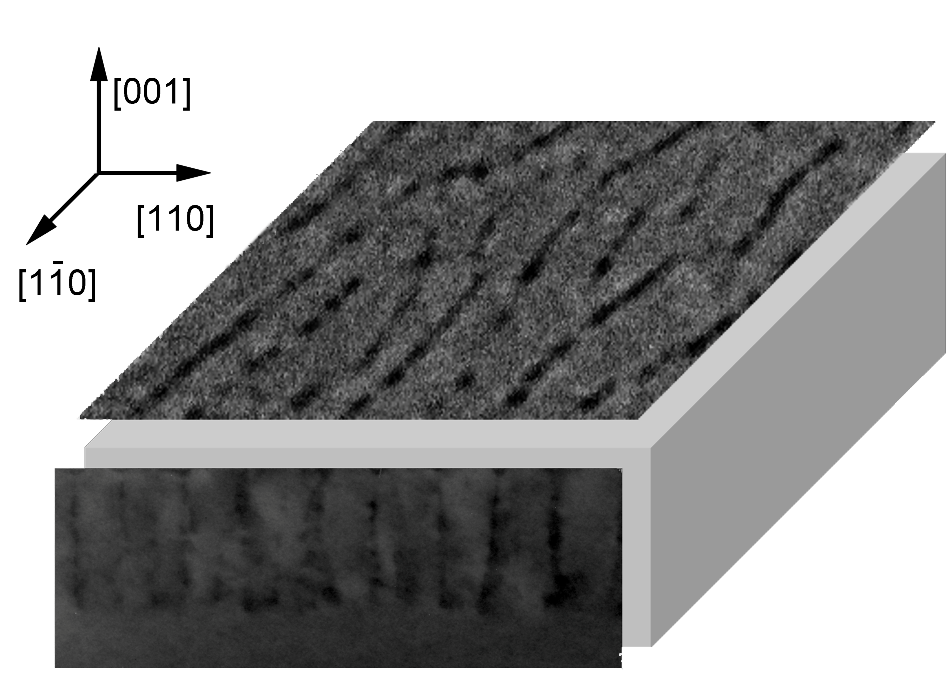Dec 10 2018
When you observe the lattice of crystals, there is often a distinct symmetry, such that no matter where you look—the atoms are evenly arranged in every direction. This behavior was also to be expected in a crystal, which physicists at the Helmholtz-Zentrum Dresden-Rossendorf (HZDR), the University of Warsaw, and the Polish Academy of Sciences created, using a distinct process: a compound from an indium arsenide semiconductor, spiked with a little iron.
 By using lasers, scientists from Germany and Poland were able to create a remarkable compound of indium arsenide and iron. Surprisingly, the compound—the black stripes in this image—formed lamellar-shaped structures in the surface of the crystal along one crystalline axis. (Photo: HZDR/S. Zhou)
By using lasers, scientists from Germany and Poland were able to create a remarkable compound of indium arsenide and iron. Surprisingly, the compound—the black stripes in this image—formed lamellar-shaped structures in the surface of the crystal along one crystalline axis. (Photo: HZDR/S. Zhou)
The material, however, did not follow perfect symmetry. The iron formed two-dimensional, lamellar-shaped structures in the crystal that lent the material an unusual property: it became magnetic. In the long term, the result could be crucial in knowing more about superconductors.
“Using the possibilities of our Ion Beam Center, we fired fast iron ions at a crystal made of indium arsenide, a semiconductor made of indium and arsenic,” says Dr. Shengqiang Zhou, physicist at the HZDR Institute of Ion Beam Physics and Materials Research. “The iron penetrated approximately one hundred nanometers deep into the crystal surface.” The iron ions remained in the minority—they made up just a few percent in the surface. The scientists then shot light pulses at the crystal using a laser. The flashes were ultra-short so that only the surface melted. “For much less than a microsecond, the top one hundred nanometers were a hot soup, whereas the crystal underneath remained cold and well ordered,” Zhou says, explaining the result.
The crystal surface cooled again within a blink of an eye after the laser assault. Something unfamiliar had taken place: the surface had fundamentally reverted back to the indium arsenide lattice structure. The cooling, however, was so fast that the iron atoms did not have adequate time to find and occupy a standard lattice state in the crystal. Instead, the metal atoms combined forces with their peers to form extraordinary structures—small two-dimensional lamellae, set in parallel.
It came as a surprise that the iron atoms were arranged in this manner. We were thus able to create such a lamellar structure for the first time globally.
Dr. Shengqiang Zhou, Physicist, HZDR Institute of Ion Beam Physics and Materials Research.
When the experts inspected the newly formed material more carefully, they established that it had become magnetic because of the influence of iron. The scientists from Poland and Germany also succeeded in theoretically defining the process and simulating it on the computer. “The iron atoms arranged themselves into a lamellar structure because this was energetically the most favorable state they could take in the brief period of time,” says Prof. Tomasz Dietl from the International Research Center MagTop at the Polish Academy of Sciences, summarizing the result of the calculations.
The result could be applicable in, for instance, comprehending superconductors—a group of materials that can conduct electricity completely without loss.
Lamellae-like structures can also be found in many superconducting materials. Our compound could, therefore, serve as a model system and help in better understanding superconductor behavior.
Dr. Shengqiang Zhou, Physicist, HZDR Institute of Ion Beam Physics and Materials Research.
This could maybe also serve to enhance their properties: in order for superconductors to function, they must currently be cooled to comparatively low temperatures of, for instance, -200 °C. The goal of a number of experts is to raise these temperatures slowly—until they discover a dream material, which loses its electrical resistance even at standard ambient temperatures.